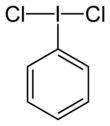Iodobenzene dichloride (PhICl2) is a complex of iodobenzene with chlorine. As a reagent for organic chemistry, it is used as an oxidant and chlorinating agent.
| |||
| Names | |||
|---|---|---|---|
| Preferred IUPAC name
Dichloro(phenyl)-λ3-iodane | |||
| Other names
Iodosobenzene dichloride; Phenyliodine(III) dichloride; Phenyliodo dichloride; Phenyliodoso chloride; Phenylchloroiodonium chloride; Dichloroiodobenzene; Iododichlorobenzene
| |||
| Identifiers | |||
3D model (JSmol)
|
|||
| Abbreviations | IBD | ||
| ChemSpider | |||
PubChem CID
|
|||
| UNII | |||
CompTox Dashboard (EPA)
|
|||
| |||
| Properties | |||
| C6H5Cl2I | |||
| Molar mass | 274.91 g·mol−1 | ||
| Appearance | Yellow solid | ||
| Density | 2.2 g/cm3 | ||
| Melting point | 115 to 120 °C (239 to 248 °F; 388 to 393 K) (decomposes) | ||
Except where otherwise noted, data are given for materials in their standard state (at 25 °C [77 °F], 100 kPa).
| |||
Chemical structure
editSingle-crystal X-ray crystallography has been used to determine its structure; as can be predicted by VSEPR theory, it adopts a T-shaped geometry about the central iodine atom.[2]
Preparation
editIodobenzene dichloride is not stable and is not commonly available commercially. It is prepared by passing chlorine gas through a solution of iodobenzene in chloroform, from which it precipitates.[3] The same reaction has been reported at pilot plant scale (20 kg) as well.[4]
- Ph-I + Cl2 → PhICl2
An alternate preparation involving the use of chlorine generated in situ by the action of sodium hypochlorite on hydrochloric acid has also been described.[5]
Reactions
editIodobenzene dichloride is hydrolyzed by basic solutions to give iodosobenzene (PhIO)[6] and is oxidized by sodium hypochlorite to give iodoxybenzene (PhIO2).[7]
In organic synthesis, iodobenzene dichloride is used as a reagent for the selective chlorination of alkenes.[1] and alkynes.[8]
References
edit- ^ a b Phenyliodine(III) Dichloride, David W. Knight and Glen A. Russell, in Encyclopedia of Reagents for Organic Synthesis, 2001, John Wiley & Sons, Ltd doi:10.1002/047084289X.rp071
- ^ E. M. Archer and T. G. van Schalkwy (1953). "The crystal structure of benzene iododichloride". Acta Crystallogr. 6 (1): 88–92. Bibcode:1953AcCry...6...88A. doi:10.1107/S0365110X53000193.
- ^ H. J. Lucas and E. R. Kennedy (1942). "Iodobenzene dichloride". Organic Syntheses. 22: 69. doi:10.15227/orgsyn.022.0069.
- ^ Zanka, Atsuhiko; Takeuchi, Hiroki; Kubota, Ariyoshi (1998). "Large-Scale Preparation of Iodobenzene Dichloride and Efficient Monochlorination of 4-Aminoacetophenone". Organic Process Research & Development. 2 (4): 270. doi:10.1021/op980024e.
- ^ Zhao, Xue-Fei; Zhang, Chi (2007). "Iodobenzene Dichloride as a Stoichiometric Oxidant for the Conversion of Alcohols into Carbonyl Compounds; Two Facile Methods for Its Preparation". Synthesis. 2007 (4): 551. doi:10.1055/s-2007-965889.
- ^ H. J. Lucas, E. R. Kennedy, and M. W. Formo (1942). "Iodosobenzene". Organic Syntheses. 22: 70. doi:10.15227/orgsyn.022.0070
{{cite journal}}: CS1 maint: multiple names: authors list (link). - ^ M. W. Formo, John R. Johnson (1942). "Iodoxybenzene: B. Hypochlorite oxidation of iodobenzene dichloride". Organic Syntheses. 22: 72. doi:10.15227/orgsyn.022.0072.
- ^ Michael E. Jung and Michael H. Parker (1997). "Synthesis of Several Naturally Occurring Polyhalogenated Monoterpenes of the Halomon Class". Journal of Organic Chemistry. 62 (21): 7094–7095. doi:10.1021/jo971371. PMID 11671809.
Further reading
edit- Tanner, Dennis D; Van Bostelen, P. B. (1967). "Free-radical chlorination reactions of iodobenzene dichloride". Journal of Organic Chemistry. 32 (5): 1517–1521. doi:10.1021/jo01280a047.

